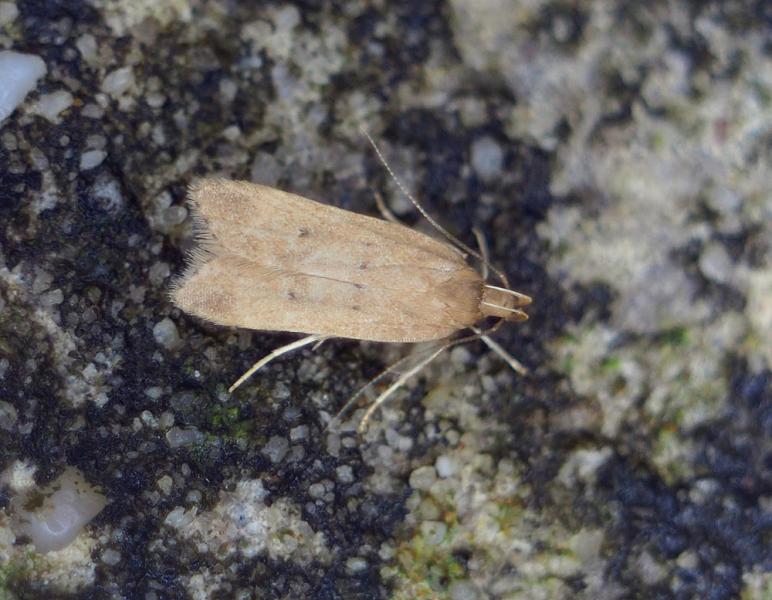35.030 Helcystogramma lutatella (Herrich-Schäffer, 1854)
Status and Distribution
Scarce, long term resident (at least since 1884) at a few coastal cliff sites in Dorset. Appeared, as a possible migrant, near Ipswich, Suffolk on 10th August 2023 and has been noted there on several occasions since suggesting possible short term establishment in the area. Found at a second Suffolk site on 10th August 2024. Elsewhere, once, near St. Brelade, Jersey (Channel Islands) in 2008.

Provisional map
Pupa
Set Specimens
Photographs of a set male and female can be seen on the Natural History Museum, Cockayne collection website:
Foodplant and Larval Feeding Signs
Dactylis glomerata (cock's-foot grass) and Brachypodium sylvaticum (false brome), the plant distribution map shows false brome.
In Europe also reported from Calamagrostis epigejos (wood small-reed), Elymus (Elytrigia) repens (common couch) and Phragmites australis (common reed).
Feeds within a rolled blade of grass forming a tube with a hole at each end fenestrating the spun part of the leaf.
Habitat
Finding the Moth
Larva: within a spun blade of grass forming a tube with a hole at each end, fenestrating the rolled part of the leaf. The larva readily and rapidly vacates the fold if disturbed and changes rolls several times before pupation.
Adult: can be disturbed from coastal cliff vegetation and comes to light.
Similar Species
There is a possibility of confusion with Brachmia inornatella although the fenland habitat of that species is unlikely to produce H. lutatella, a moth of southern coastal cliffs. The gently curved termen of the forewing in H. lutatella compares with the distinctly sinuate termen in B. inornatella.
In the past, the separation of this species from H. rufescens was based on the presence or absence of blackish stigmata on the forewing. This was proved to be unreliable by Heckford and Sterling (1999) who gave the key identification features as follows:
H. lutatella - the forewings are grey-brown to brown and lack the ochreous coloured veins of H. rufescens. The labial palps are white above and below (without brown scales) and the hindwing of the female pale to dark grey. In H. rufescens the forewing is ochreous (or veins ochreous with brown scaling), the outer margins of the labial palps have brown scales and the hindwing of the female is whitish.
Separating the larva of these two species is more readily achieved in early instars. In H. lutatella, the abdominal segments one and two are black with a reddish or reddish brown sclerotized plate on each anteriorly, smaller on segment one, confined to the dorsum and rounded with small lateral extensions. In H. rufescens, these two segments are black with the sclerotized plates dark olive (early instar) becoming pale brown in later instars. The plate on segment one is very small consisting of a narrow, linear band, hardly broadening about the dorsum.
Microscopic examination of small, pale, worn moths is recommended in extreme southern coastal areas where the shape of the sclerite of tergite 1 and 2 in both sexes are distinctly horse-shoe shaped in H. rufescens and boomerang shaped in H. lutatella (see link to the genitalia in the Images section above). Otherwise, only differences in the female genitalia are of any practical use in separating the two species (Heckford and Sterling, 1999 - full reference can be found in the Publications: Published Papers section of this site).
H. rufescens can, on occasions, have small dark stigmata in the middle of the forewing at one-third and two-thirds.
Single brooded from July to early September.
There are very few records of the imago, most records relating to bred specimens.


_0.jpg)
